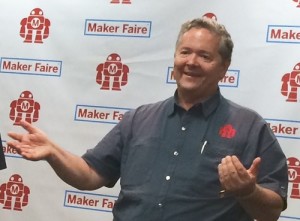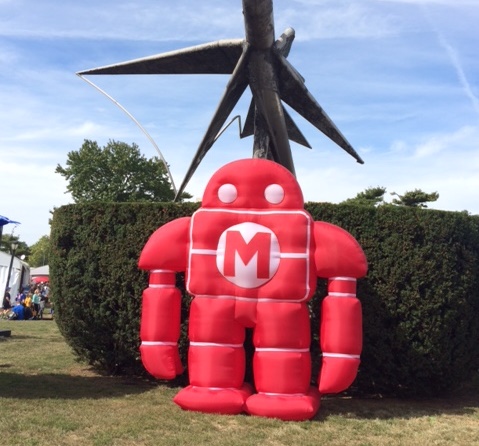By Jane Applegate
Quin Etnyre, the 14 year-old CEO of www.Qtechknow.com, was attracting a crowd at the recent Maker Faire in Queens, N.Y. He was demonstrating his new invention—a portable printer about as big as a pack of cigarettes—that he built using miniature Atmel Corp. www.atmel.com microprocessors and Arduino circuit boards. The device uses a roll of cash register receipt paper to spool out cool, black and white vintage-looking photos taken by a smartphone.
Etnyre was among the tens of thousands of makers and maker wanna-be’s—attending a recent Maker Faire at New York Hall of Science. An estimated 80,000 people of all ages attended the Faire, which boasted about 800 exhibits featuring everything from super-fast, Italian-made 3-D printers to cardboard hats, toy robots and NASA reps touting space travel.
 “We are creating a different kind of economy,” said Dale Dougherty, co-founder of Maker Faire and Maker Media, publisher of Make Magazine. www.makerfaire.com “The hallmark of this community is the sharing of skills.”
“We are creating a different kind of economy,” said Dale Dougherty, co-founder of Maker Faire and Maker Media, publisher of Make Magazine. www.makerfaire.com “The hallmark of this community is the sharing of skills.”
Since 2006, the Faires have attracted more than 1.1 million attendees at events in 30 countries. This year, Faires in Shenzhen, China drew 100,000 people and 70,000 in Rome.
Dougherty, who said he was inspired by school science fairs, describes the maker movement as the “intersection of science, technology and art.” At a press conference, he urged parents to “stop buying toys and start buying tools.”
On a brilliant, sunny day, kids and parents lined up to test Dremel drills and a plethora of other tools for making robots and other gadgets.
“Makers are a loosely-affiliated group of people united by creativity and a passion for making stuff,” said Rick Silvestrini, chief marketing officer for Roblox, www.roblox.com
an online media and educational company based in San Mateo, Calif. Roblox, funded with about $7 million in venture and angel money, offers software that enables anyone with basic computer skills to design computer games. The company, which had a popular booth at the Queens Faire, claims on its website that its customers have spent 70 million hours creating about 15 million video games.
“Our platform enables kids to build and create something—and share it,” said Silvestrini, adding that grown-ups also use the platform to create games.
Two days before the Faire, a mix of business leaders, big thinkers and artists gathered for Maker Con, a daylong conference on the future of the Maker Movement.
David Ehrenberg, president and CEO of the Brooklyn Navy Yard Development Corp., said his former shipyard is now home to a range of tenants including Sweet ‘n Low’s packaging division and a start-up that makes high-tech body armor for the military. “We’re really quite bullish about manufacturing,” said Ehrenberg.
James Fallow, national correspondent for The Atlantic, said American politicians and policymakers must provide better career and technical education in order to bring well-paying manufacturing jobs back to this country.
“Industrial jobs still pay 70 to 100% more than service jobs,” said Fallows. “And, 47% of industrial workers have no college degree.”
The maker movement is “taking us back from the edge…and creating a sense of making a new society,” said Paul Roehrig, managing director of Cognizant’s Center for the Future of Work. Cognizant is a publicly traded consulting company.
John Ditamos, Kickstarter’s leader of design and tech outreach, said the crowd-funding company has helped 90,000 “independent creators” raise millions of dollars. He said makers have lots of enthusiasm and creativity, but often need funding and business skills.
While many makers are building toys, tools and products in their basements, bedrooms and garages, there are thousands of makers working in ‘maker’ and ‘hackerspaces’ operating around the country. There are 1,187 self-identifying hackerspaces across the country, according to a recent survey by Dr. Heidi Neck and research assistant Charles Plaisimond at Babson College, a leading entrepreneurial college in Wellesley, MA. www.babson.edu
California, New York, Michigan, Florida, Georgia, Texas and Washington boast the most maker spaces, which offer a variety of services including training, access to supplies, access to free computer software, 3-D printers and a variety of tools, laser cutters and mills for manufacturing, according to the Babson report.
Many maker spaces are membership-based. Some are located in public libraries or on college campuses including MIT. About a third are organized as nonprofits.
Jane Applegate is the East Coast correspondent for SmallBizDaily.com. Follow her at @janewapplegate.







